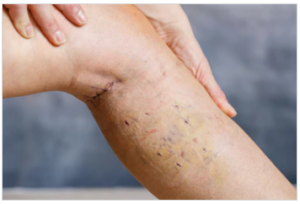If you have the condition, you might be wondering: Is surgery the only option for varicose veins? You’ll be happy to learn that new and minimally invasive (i.e., non-surgical treatments) emerged over the past few decades. So while it’s possible that surgery may be the best option for your veins depending on their size and scale, most can get non-surgical treatment.
How Does Surgical Stripping Work?
Surgery is performed under general anaesthetic, with local anaesthetic also applied to the leg. Once under, a small incision is made at the top of your leg, at the groin, and another made at the ankle. Your surgeon blocks off the blood supply to the vein, then inserts a fine wire through the length of the vein. The wire is secured to the vein and then pulled back out. Removing the wire will also remove the vein it’s secured to, stripping it from your leg. Smaller incisions may be made along the leg, stripping smaller veins also, if necessary.
What are the alternatives to Varicose Vein Surgery?
Endovenous Laser Ablation
In EVLA, we use a thin fibre with a laser tip to heat the vein and seal it shut. Once shut, your body will start absorbing the vein, making it disappear in a few weeks to months. As part of the process, we inject a regional anaesthetic to numb the area. We also only need to make a tiny 1mm incision to feed the fibre through, meaning you won’t need any sutures or stitches.
Radiofrequency Ablation
RFA is very similar to EVLA. However, instead of laser bursts, we use radiofrequency bursts to heat the vein and seal it shut. Both EVLA and RFA are considered Gold-Standard treatments, as they have a ~98% success rate and a less than 1% risk of complications.
Sclerotherapy
Like vascular surgery, sclerotherapy is also an old treatment for varicose veins, with the earliest medical reference to sclerotherapy made in 1850. During the procedure, we inject a sclerosant into the vein to irritate its lining, making it seal shut. Unlike EVLA and RFA, sclerotherapy isn’t well-suited to large veins, as the sclerosant can’t cover enough ground for a proper seal. However, it’s a great option for the smaller and twisted veins that the EVLA fibre can’t manoeuvre through.
ClariVein
ClariVein is similar to sclerotherapy, but instead of syringe injections, we use the ClariVein Catheter. It has a special 360-degree rotating tip that injects sclerosant directly into the vein wall, making it suitable for larger veins.
Medical Superglue
In Medical Superglue treatments, specialists inject a special substance (usually VenaSeal, VenaBlock or VeinOff) into the vein to glue it shut. This procedure is best for mid-sized varicose veins.
A few other benefits of non-surgical treatment include a relatively short treatment process (30-45 minutes) and an easier recovery. After your treatment is done. you’ll just need to walk for 30 minutes. Then, you can get back to your day. The only caveats are that you should avoid strenuous exercise (like weightlifting, sprinting, and CrossFit) and long hours of sitting or standing for 3-5 days. Your clinician might also ask you to wear compression socks for a few days, walk for 30 minutes a day for 2 weeks, and drink plenty of water to keep common side effects like swelling, redness, and aches to a minimum.
Will I need surgery?
We can’t say whether or not you’ll need surgery without a consultation. But generally, specialists recommend procedures like ambulatory and transilluminated phlebectomy in cases where the varicose veins are very large and complex.
After the Procedure What Can I Expect?
Once the procedure is complete, you can expect a recovery time of up to four weeks. Immediately after your veins have been stripped, your leg will have been bandaged securely. The pressure of the bandages will help against swelling and bruising, and assist with circulation. Bandages or medical-grade compression stockings should be worn for up to ten days post-procedure.
After stripping, like with many procedures, discomfort is to be expected. Your leg may also be bruised or tender for several weeks, and the scars from the incisions may remain visible for up to a year. While elevating your leg is important, gentle exercise over the next few days will help you heal, despite causing mild discomfort. Resting too often will increase the risk of developing blood clots, or deep vein thrombosis (DVT).
Can Varicose Veins Come Back?
Even though varicose vein surgery is highly effective, it cannot prevent new varicose veins from developing. Many things contribute to the development of varicose veins, and unfortunately, not many prevent them.
While women are more likely to develop varicose veins, it doesn’t mean men are unlikely to develop them. Your chances of developing them are higher if your mother or father has them, if you’re overweight, have a job that requires prolonged sitting or standing, or if you are pregnant.
Why Don’t We Perform Surgery?
Specialists consider new treatments such as EVLA and RFA safer, and in some cases, more effective than stripping. On top of that, they don’t require anaesthesia or a long recovery process. Specialists can address most veins through minimally invasive treatments, with surgeries generally reserved for more severe cases.
See the Australian Dept of Health report by clicking here reviewing endovenous laser ablation.
Read more: Does ambulatory phlebectomy hurt?
Seek expert advice
The doctors at The Vein Institute specialise in varicose vein treatment. We offer patients a comprehensive treatment program to treat varicose veins, with non-surgical laser treatment techniques. The benefits of laser treatment to patients are;
- Walk-in walk-out treatment
- 98% success rate
- Extremely effective
- Can be performed at a clinic (no hospitalisation)
- No general anaesthetic
- Medicare rebates apply
- No downtime or time away from work
Call us at 13 VEINS (that’s 13 83467), or fill out our booking request form.







